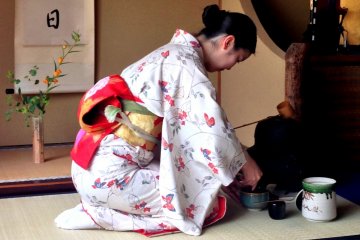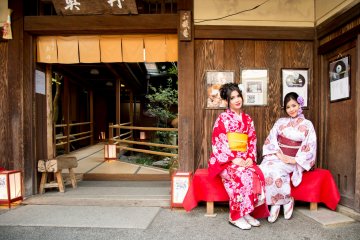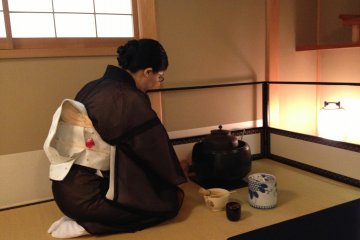What are the three things you will think about when I mention Kyoto? Temples, Maiko San (Apprentice Geishas), of course and tea culture! Experiencing an authentic Japanese tea ceremony should be part of your bucket list when you visit Kyoto.
The tea room Juan is a great way for English speakers to experience traditional tea culture in Japan. In Japanese, Ju means to join together. An represents a tea house. So most tea houses will have the word An in their name. The host, Mrs. Kirihata, founded this tea house so guests from the world may join each other to enjoy the tea. In tea culture, Japanese have a famous motto, “Ichigo, Ichie,” saying that the every tea ceremony is unique, a true once in a lifetime experience and can never be repeated. Every moment during the tea ceremony has meaning, a tribute to the sophisticated tea culture which has developed over many centuries.
For the tea ceremony, the host takes great care in choosing the tea materials for the specific occasion. The highest quality of tea leaves come from the hills outside Uji, between Kyoto and Nara, picked in spring time. To make good quality tea, only the young leaves are selected to ensure the best taste. These leaves are used to make Matcha powder. The host carefully selects the best tea powder to honor the guest.
There are 4 important elements in a tea ceremony. The first one is “Wa,” which means peace and harmony. The second one is “Kei,” which stands for respect. The tea culture in Japan already has a few hundred years’ history. Each participant in the tea room should respect the art and help each other to enjoy the joy of the ceremony. “Sei” is the third element, representing purity. In the tea house, everyone and everything should be purified. The last element, “Jaku,” means steadfast faith. This unfaltering faith gives people strength. These four elements are for people to know and to apply to their lives. The whole tea culture is very profound, one that permeates in every part of our daily life.
The host of Juan, Mrs. Kirihata, introduced the ceremony process step by step. First, the greeting; the host will put a Japanese fan in front of him or her, and then bows. Then, the host will offer the sweet with the white paper and a tiny cutting knife before offering the tea. After the guest finishes the sweet, the host will come again to start the tea making process. The tea ceremony offers two kind of tea: strong tea, which is bitter, and the light tea. There are two type of tea ceremony: one is the formal tea ceremony, the total process will take 3 to 4 hours, the host will prepare a light meal first, and then the guest can enjoy the strong tea. Nowadays, the light tea is more popular because the light tea ceremony only takes within one hour.
When I first entered the tea room in Juan, the Japanese style decoration caught my eye. This tea room is designed in the traditional layout of four and half tatami mats, so the host can serve up to six people at the same time. On the wall hangs calligraphy and painting from a celebrity with the writing “Juan.” Depending on the season and occasion, the host will choose the most appropriate bowls to offer to the guest. Each tea utensil has an unique meaning. The water container and all the tools for the tea ceremony are special; as they are represent the four elements of tea ceremony. When you enjoy the tea, please do not forget to appreciate and reflect on the pattern on the tea bowl.
When the host serves you the tea, he or she will turn the pattern on the bowl to face you and show respect towards you. Before you drink it, you have to turn the same pattern on the bowl to face the host to return your respect towards the host. After you drink the tea, you have to turn the pattern to face you again to admire the design on the bowl. The whole process of tea ceremony is an experience in observing and tasting art.
For the Japanese people, tea ceremony is not only a way to commune with the guests but also an art form to showcase its ancient history and culture. Mrs. Kirihata, Juan’s host, is devoting herself as an ambassador for Japanese tea culture. She founded the tea house to make the rich layers of the tea ceremony accessible for visitors from around the world. It was a once in a lifetime experience for me.












